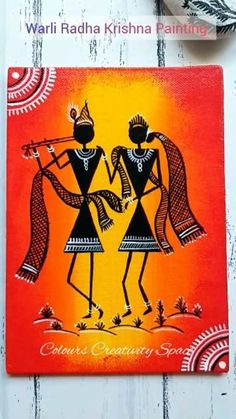Warli Art
Warli art, originating from the Warli tribe of Maharashtra, India, is a traditional tribal art form known for its simplistic yet expressive style. This class note explores the integration of Warli art into fashion design, covering its historical context, artistic techniques, cultural significance, design applications, contemporary adaptations, and practical considerations for fashion designers looking to incorporate this unique art form into their collections.

Historical Context
Warli art dates back to approximately 2500-3000 BCE and is believed to be one of the oldest forms of tribal art in India. Originating in the Warli tribe, primarily inhabiting the Thane district of Maharashtra, Warli art was traditionally practiced by women as a way to depict daily life, rituals, and folklore on the walls of their homes. The art form uses basic geometric shapes such as circles, triangles, and squares, often in white pigment on a mud base, reflecting the tribal community’s close connection to nature and their spiritual beliefs.
Artistic Techniques
1. Materials Used:
- Natural Pigments: Traditionally, Warli art is created using white pigment made from rice paste or other natural materials, applied on a dark background.
- Modern Adaptations: In contemporary applications, Warli art may also use acrylic paints or other mediums suitable for fabric and clothing.
2. Iconography and Symbols:
- Geometric Shapes: Circles symbolize the sun and moon, triangles represent mountains and trees, and squares depict sacred enclosures or ritual spaces.
- Human Figures: Stick figures with triangular bodies and circular heads represent human forms engaged in daily activities, rituals, or celebrations.

3. Technique:
- Freehand Painting: Warli art is traditionally painted freehand, using a bamboo stick or brush with a pointed end to create fine lines and intricate patterns.
- Pattern Repetition: Designs often feature repetitive patterns and motifs, creating a rhythmic and harmonious visual effect.
Cultural Significance
Warli art holds deep cultural significance within the Warli tribe and broader Indian society:
- Community Identity: Warli art serves as a cultural identifier for the Warli tribe, preserving their traditions and ancestral knowledge.
- Spiritual Beliefs: Many motifs and symbols in Warli art are rooted in spiritual beliefs, reflecting a harmonious relationship between humans and nature.
- Narrative Tradition: Each artwork tells a story, depicting rituals, festivals, and everyday life events within the tribal community.
Design Applications in Fashion
1. Couture and High Fashion:
- Hand-Painted Garments: Designers incorporate Warli motifs and patterns into couture pieces, creating bespoke garments that celebrate tribal artistry.
- Embroidery and Appliqué: Warli-inspired embroidery or appliqué techniques add texture and depth to garments, enhancing their visual appeal.
2. Ready-to-Wear Collections:
- Printed Fabrics: Warli patterns printed on fabrics for ready-to-wear clothing lines, offering a blend of cultural heritage and contemporary fashion trends.
- Mix and Match: Warli motifs used in mix-and-match ensembles, allowing consumers to express individual style while appreciating tribal art.
3. Accessories and Textiles:

- Scarves and Shawls: Warli art motifs adorn scarves and shawls, transforming everyday accessories into cultural statements.
- Bags and Footwear: Handbags, clutches, and footwear embellished with Warli designs, appealing to fashion-forward consumers with an appreciation for artisanal craftsmanship.
Contemporary Adaptations
In modern fashion design, Warli art has evolved beyond traditional boundaries:
1. Fusion with Contemporary Styles:
- Urban Wear: Warli art motifs adapted to urban streetwear, blending tribal aesthetics with modern fashion sensibilities.
- Global Appeal: Designs that resonate with international audiences, promoting cross-cultural understanding and appreciation.
2. Collaborations and Social Impact:
- Artisan Collaborations: Fashion brands collaborating with Warli artisans to co-create collections, promoting sustainable and ethical fashion practices.
- Empowerment Initiatives: Supporting tribal communities through fair trade practices, ensuring artisans receive fair compensation for their craftsmanship.
3. Sustainability and Eco-Friendly Practices:
- Natural Dyes: Incorporating natural dyes and organic fabrics in Warli-inspired fashion lines, promoting environmental sustainability.
- Upcycling: Using recycled materials or vintage fabrics adorned with Warli motifs, aligning with the principles of circular fashion.
Practical Considerations for Designers
1. Cultural Sensitivity:
- Respect for Traditions: Understanding the cultural significance of Warli art and ensuring designs respect its sacred symbols and narratives.
- Collaboration: Engaging with Warli artisans or cultural experts to ensure authenticity and ethical representation in fashion designs.
2. Design Innovation:
- Experimentation: Exploring new techniques and materials while staying true to the essence of Warli artistry.
- Adaptability: Adapting Warli motifs to different fashion contexts and consumer preferences without compromising cultural integrity.

3. Quality and Craftsmanship:
- Attention to Detail: Emphasizing craftsmanship and quality in the execution of Warli-inspired designs, ensuring durability and aesthetic appeal.
- Finishing Touches: Paying attention to finishing touches such as neat edges and secure seams to enhance the overall look and feel of garments.
Conclusion
Warli art in fashion design offers a unique opportunity to celebrate tribal heritage, promote cultural diversity, and showcase artisanal craftsmanship on a global stage. By integrating Warli motifs into fashion collections, designers not only create visually striking pieces but also contribute to the preservation and appreciation of indigenous art forms. As the fashion industry continues to evolve, Warli art serves as a testament to the enduring beauty of tribal traditions and their relevance in contemporary fashion, inspiring creativity, cultural exchange, and sustainable practices in the global marketplace.
